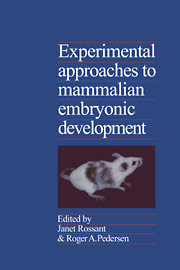Book contents
- Frontmatter
- Contents
- Preface
- Contributors
- Cellular aspects
- Molecular and biochemical aspects
- 6 Regulation of gene expression during mammalian spermatogenesis
- 7 Molecular aspects of mammalian oocyte growth and maturation
- 8 Utilization of genetic information in the preimplantation mouse embryo
- 9 Metabolic aspects of the physiology of the preimplantation embryo
- 10 Role of cell surface molecules in early mammalian development
- 11 Cell-lineage-specific gene expression in development
- 12 X-chromosome regulation in oogenesis and early mammalian development
- Toward a genetic understanding of development
- Index
10 - Role of cell surface molecules in early mammalian development
from Molecular and biochemical aspects
Published online by Cambridge University Press: 31 March 2010
- Frontmatter
- Contents
- Preface
- Contributors
- Cellular aspects
- Molecular and biochemical aspects
- 6 Regulation of gene expression during mammalian spermatogenesis
- 7 Molecular aspects of mammalian oocyte growth and maturation
- 8 Utilization of genetic information in the preimplantation mouse embryo
- 9 Metabolic aspects of the physiology of the preimplantation embryo
- 10 Role of cell surface molecules in early mammalian development
- 11 Cell-lineage-specific gene expression in development
- 12 X-chromosome regulation in oogenesis and early mammalian development
- Toward a genetic understanding of development
- Index
Summary
Introduction
Multicellular organisms exist through the cooperative interactions of single cells that become programmed during development to carry out specific functions. This programming occurs in a sequential and orderly fashion and, at least in the earliest events that can be studied in the mammalian embryo, may be brought about by cues transmitted from cell to cell by cell surface molecules.
In the mouse embryo the first such morphogenetic event, compaction, occurs at the late 8-cell stage, when the individual spherical blastomeres flatten against each other and maximize their cell contacts (Ducibella and Anderson 1975; Lehtonen 1980) (see Chapter 2). Concurrent with this change in shape is the development of more specialized contacts such as desmosomes and focal tight junctions (Ducibella et al. 1975; Magnuson, Jacobson, and Stackpole 1978; Ducibella and Anderson, 1979), and the start of intercellular communication via gap junctions (Lo and Gilula 1979; Lo 1980; Goodall and Johnson 1982, 1984). Moreover, surface and cytoplasmic polarity become evident: On the surface, short microvilli become restricted to an apical pole (Calarco and Epstein 1973; Ducibella et al. 1975; Ziomek and Johnson, 1980; Reeve and Ziomek 1981), while the nucleus occupies the basal region of the blastomeres (Reeve and Kelly 1982), and the intervening cytoplasm becomes increasingly filled with various organelles (Ducibella et al. 1977; Reeve 1981; Fleming 1984). Compaction is followed, after 24 h, by cavitation, which marks the onset of the blastocyst stage. Here the embryo consists of an outer single layer of cells, the trophectoderm, surrounding a fluid-filled blastocoelic cavity and an aggregate of cells called the inner cell mass.
- Type
- Chapter
- Information
- Experimental Approaches to Mammalian Embryonic Development , pp. 293 - 320Publisher: Cambridge University PressPrint publication year: 1987



